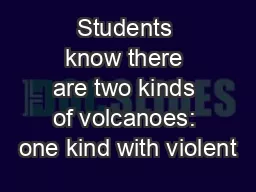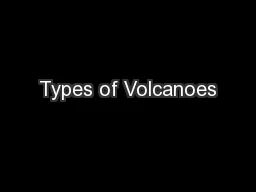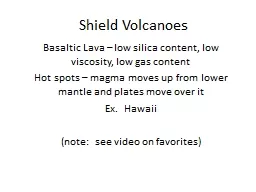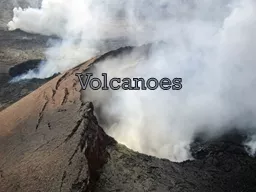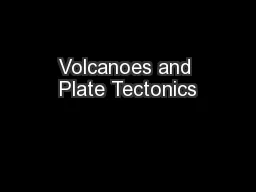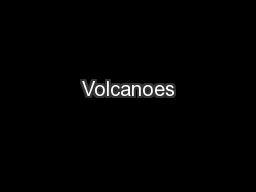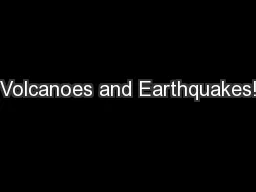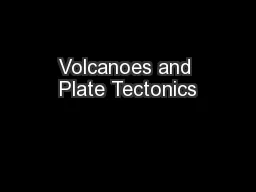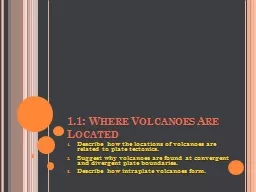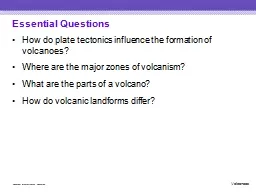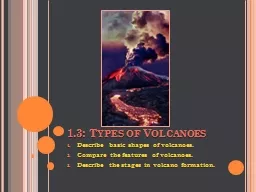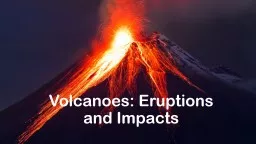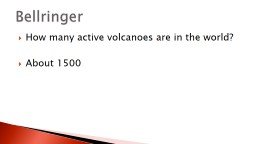PDF-Students know there are two kinds of volcanoes: one kind with violent
Author : olivia-moreira | Published Date : 2016-03-23
3e eruptions producing steep slopes and the other kind with voluminous lava flows producing gentle slopes What do you notice about this volcanic eruption What about
Presentation Embed Code
Download Presentation
Download Presentation The PPT/PDF document "Students know there are two kinds of vol..." is the property of its rightful owner. Permission is granted to download and print the materials on this website for personal, non-commercial use only, and to display it on your personal computer provided you do not modify the materials and that you retain all copyright notices contained in the materials. By downloading content from our website, you accept the terms of this agreement.
Students know there are two kinds of volcanoes: one kind with violent: Transcript
3e eruptions producing steep slopes and the other kind with voluminous lava flows producing gentle slopes What do you notice about this volcanic eruption What about this one Magma x2022. Chapter 5. Rigid Earth to Plate Tectonics. Learning Objectives. Know the different types of volcanoes and their associated features. Understand the relationship of the volcanoes to plate tectonics. Know what geographic regions are at risk from volcanoes. Frequency and Quantity. There are ~ 550 historically active volcanoes. About 60 erupt annually. The majority are 1) at the edge of continents and 2) underwater. Dormant volcanic cone in Japan. What causes volcanoes?. Basaltic Lava – low silica content, low viscosity, low gas content. Hot spots – magma moves up from lower mantle and plates move over it . Ex. Hawaii. (note: see video on favorites). Shield Volcanoes. Target #16- I can summarize the conditions needed for magma to form. Despite the high temperature in the mantle, most of the layer remains solid due to extreme pressure. Magma: . liquid rock produced under Earth’s surface. Volcanism is mostly focused at plate margins. Pacific Ring of Fire. This map shows the margins of the Pacific tectonic plate and surrounding region. The red dots show the location of active volcanism. Notice how the majority of the volcanism is focused in lines along the plate boundaries? For this region is the area known as the “Pacific Ring of Fire”.. VOLCANOES.. What is a volcano?. A volcano is a mountain that opens . below . to a pool of molten rock . called a magma chamber below . the surface of the earth. When . the pressure . builds up, eruptions take place. . Warm Up. Why do you think magma rises? Consider an ice cube floating at the top of a glass of water. Objective:. SWBAT. Describe at least two of the three types of volcanoes and how they form. Agenda:. Volcanism is mostly focused at plate margins. Pacific Ring of Fire. This map shows the margins of the Pacific tectonic plate and surrounding region. The red dots show the location of active volcanism. Notice how the majority of the volcanism is focused in lines along the plate boundaries? For this region is the area known as the “Pacific Ring of Fire”.. By Mary . Knutson RN. Objectives:. To recognize signs of emotional distress in students. To list three or more ways to help students in emotional distress. To recognize high risk factors corresponding to potentially violent students. Describe how the locations of volcanoes are related to plate tectonics.. Suggest why volcanoes are found at convergent and divergent plate boundaries.. Describe how . intraplate. volcanoes form.. Volcanic activity takes place primarily at . Where are the major zones of volcanism?. What are the parts of a volcano?. How do volcanic landforms differ?. Copyright © McGraw-Hill Education. Volcanoes. Review. convergent. New. volcanism. hot spot. Compare the features of volcanoes.. Describe the stages in volcano formation.. What are Volcanoes?. Volcanoes are vents through which molten rock and gas escape from a . magma chamber.. Volcanoes can differ. What are volcanoes?. Does anyone know what a volcano is?. A volcano . is a landform (usually a mountain) where . liquid rock . erupts through the surface of the planet. .. The name "volcano" has its origin from the name of Vulcan, a god of fire in Roman mythology.. About 1500. Bellringer. Begin volcano video and questions. Objective. Pick one way to trigger a tsunami (1). Include one real life example (1). Describe how a tsunami wave is different from a wind wave (2).
Download Document
Here is the link to download the presentation.
"Students know there are two kinds of volcanoes: one kind with violent"The content belongs to its owner. You may download and print it for personal use, without modification, and keep all copyright notices. By downloading, you agree to these terms.
Related Documents

